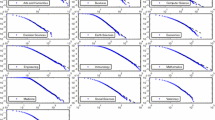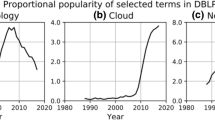Abstract
The non-Gaussian character of scientific activity is discussed. This character makes correct only non-Gaussian approximations of stationary distributions of scientific activity. Deviation of different non-Gaussian approximations from the Zipf distribution can be explained in some cases by distortion introduced by the observer. The hypothesis that latent stationary distributions of scientific (and generally human) activity for separate person are always described by the Zipf distribution is formulated using the considerations connected with the variational entropy and the Zigler principles.
Similar content being viewed by others
Notes and References
S. D. HAITUN, Stationary, scientometric distributions. Part I. The different approximations —Scientometrics, 4 (1982) No. 1; Part II. Non-Gaussian nature of scientific activities. —Scientometrics, 4 (1982) No. 2.
The definition of latent and indicator parameters see, for example: S. D. HAITUN, Scientometric investigations in the USSR.Scientometrics, 2 (1980) 65–84.
For example, see: O. U. GROOS. Bradford's law and the Keenan-Atherton data,American Documentation, 19 (1967) 46.
See: D. H. LEAVENS, Communication from Dikson H. Leavens,Econometrics, 21 (1959) 630; D. J. de S. PRICE,Little Science, Big Science. Columbia Univ. Press, N. Y.-L., 1963; R. MITTERMERR, K. D. KNORR, Scientific productivity and accumulative advantage: a thesis reassessed in the light of international data,R & D Management, 9 (1979) 235–239.
B. MANDELBROT, Contribution a la theorie mathematique des jeux de communication. Ph. D. Thesis, Paris, Dec. 16, 1952, Publ. de l'Inst. de Statistique de l'Univ. de Paris, Vol. 2, No. 1, 2, p. 80–102, 1953.
Yu. A. SHREIDER, O vozmozhnosti teoreticheskogo vyvoda statisticheskikh zakonomernostey teksta (The Zipf distribution and the variational principle of the maximum of entropy),Problemy peredachy informatsiyi, 3 (1967) 57–63.
A. I. YABLONSKY, Stokhasticheskiye modely nauchnoy deyatelnosti (Stochastic models of research activities) in:Sistemniye issledovaniya. Yezhegodnik, 1975 (System Research, Yearbook — 1975), M., 1976, p. 5–42; A. I. YABLONSKY, On fundamental regularities of the distribution of scientific productivity,Scientometrics, 2 (1980) 3–34.
I. J. GOOD,Statistics of Language. The Encyclopedia of Linguistic. Information and Control, Pergamon Press, Oxford, 1969.
A. BOOKSTEIN,Bibliometric symmetry and the Bradford-Zipf laws. University of Chicago, Graduate Library School, 1975.
G. U. YULE, A mathematical theory of evolution based on conclusions of dr. I. C. Willis,Phylosophical Transactions of the Royal Society, Ser. B, 213 (1934) 21–87.
D. G. CHAMPERNOWNE, A model of income distribution.Econometrical J., 63 (1953) 318.
H. A. SIMON, On a class of skew distribution function.Biometrica, 42 (1955) 425–440.
I. STEINDL,Random Process and the Growth of Firms, N.Y., 1965.
I. S. CRAMER,Empirical Econometrics, Amsterdam, L., 1969.
A. I. YABLONSKY, 1976, op. cit., note 7. Stokhasticheskiye modely nauchnoy deyatelnosti (Stochastic models of research activities) in:Sistemniye issledovaniya. Yezhegodnik, 1975 (System Research, Year-book —1975), M., 1976, p. 5–42.
D. J. de S. PRICE, A general theory of bibliometric and other cumulative advantage processes.J. of the American Society for Information Science, 27 (1976) 292–306.
B. M. HILL, Zipf's law and prior distributions for the comparison of a population,J. of the American Statistical Association, 65 (1970) 1220–1232; B. M. HILL, Rank frequency forms of Zipf's law.J. of the American Statistical Association, 69 (1974) 1017–1026; B. M. HILL, M. W. WOODROOFE, Stronger forms of Zipf's law.J. of the American Statistical Association, 70 (1975) 212–219.
J. H. RAVICHANDRA RAO, The distribution of scientofic productivity and social change.J. of the American Society for Information Science, 31 (1980) 111–122.
A. I. YABLONSKY, op. cit., note 7. Stokhasticheskiye modely nauchnoy deyatelnosti (Stochastic models of research activities) in:Sistemniye issledovaniya. Yezhegodnik, 1975 (System Research, Yearbook — 1975), M., 1976, p. 5–42.
D. J. de S. PRICE, op. cit., note 4..
A. I. YABLONSKY,Modeli i metody matematicheskogo issledovaniya nauki. Nauchno-analitichesky obzor (Models and Methods of Mathematic Investigations of Science, Review), M., 1977.
S. S. STEVENS, Neural events and the psychological law.Science, 170 (1970) No. 3962, 1043–1050.
See: R. MITTERMERR, K. R. KNORR, op. cit., note 4..
J. P. BRITTON, The productivity of scientists: a prelude to manpower studies. Mimeographical paper, Yale University, 1963.
R. K. MERTON, The Matthew effect in science.Science, 59 (1968) 56–63.
J. COLE, S. COLE,Social Stratification in Science. Chicago Univ. Press., Chicago, 1973.
R. D. ALLISON, J. A. STEWART, Productivity differences among scientists: evidence for accumulative advantage.American Sociological Review, 39 (1974) 596–606.
D. J. de S. PRICE, op. cit., note 16..
Ibid..
J. K. RAVICHANDRA RAO, op. cit., note 18..
P. BURDIEU, The specificity of the scientific field and the social condition of the progress of reason.Social Science Information, 14 (1975) 19–47.
K. D. KNORR, 1977, see: R. MITTERMERR, K. D. KNORR, op. cit., note 4..
For example, see: E. FERMI, On the origin of the cosmic radiation,Phys. Review, 75 (1949) 1169–1174; V. L. GINZBURG, The astrophysics of cosmic rays,Scientific American, 220 (1969) 51–63.
H. ZIEGLER, Some extrerum principles in irreversible thermodinamics with application to continuum mechanics, in:Progress in Solid Mechanics, Vol.IV, North-Holland Publ. Co., Amsterdam, 1963, Chapter II; S. D. HAITUN, K voprosu o ponyatiyi entropiyi (On concept of entropy), in:Problemy istoriyi i metodologiyi nauchnogo poznaniya (Problems of History and Methodology of Knowledge), Nauka, Moscow, 1974, p. 281–294.
E. W. MONTROLL, W. W. BADGER,Introduction to Quantitative Aspects of Science Phenomenon, Gordon and Breach Science Publ., N. Y., L., Paris, 1974.
D. J. de S. PRICE, D. de B. BEAVER, Collaboration in an invisible, collegeAmerican Psychogist, 21 (1966) No. 11.
Author information
Authors and Affiliations
Rights and permissions
About this article
Cite this article
Haitun, S.D. Stationary scientometric distributions. Scientometrics 4, 181–194 (1982). https://doi.org/10.1007/BF02021059
Received:
Revised:
Issue Date:
DOI: https://doi.org/10.1007/BF02021059




